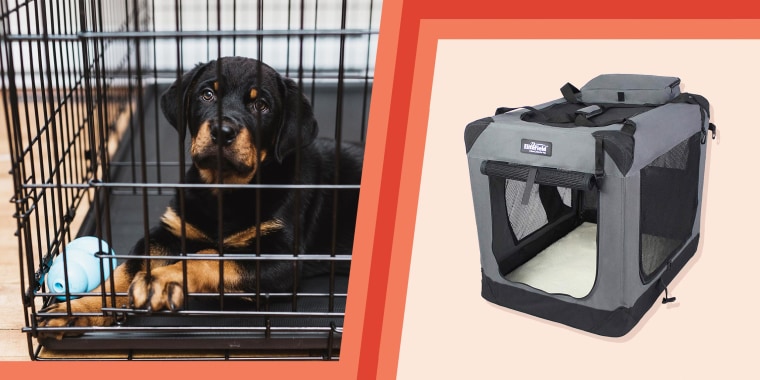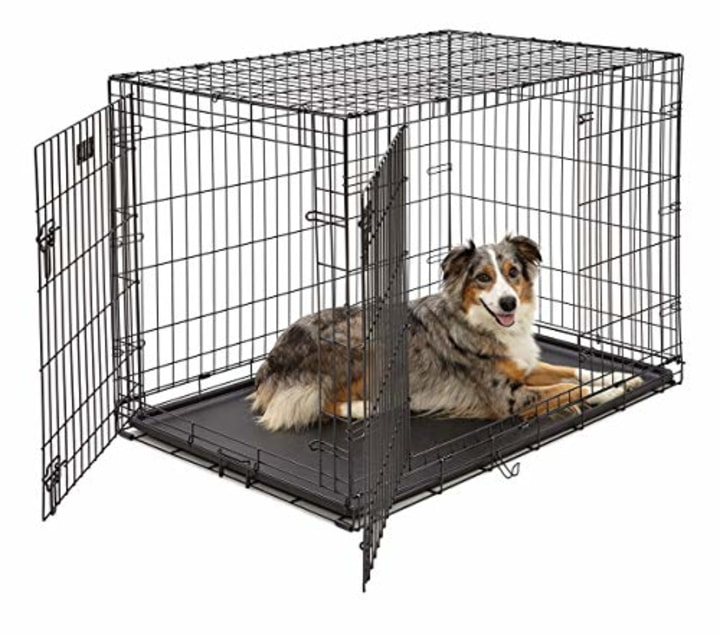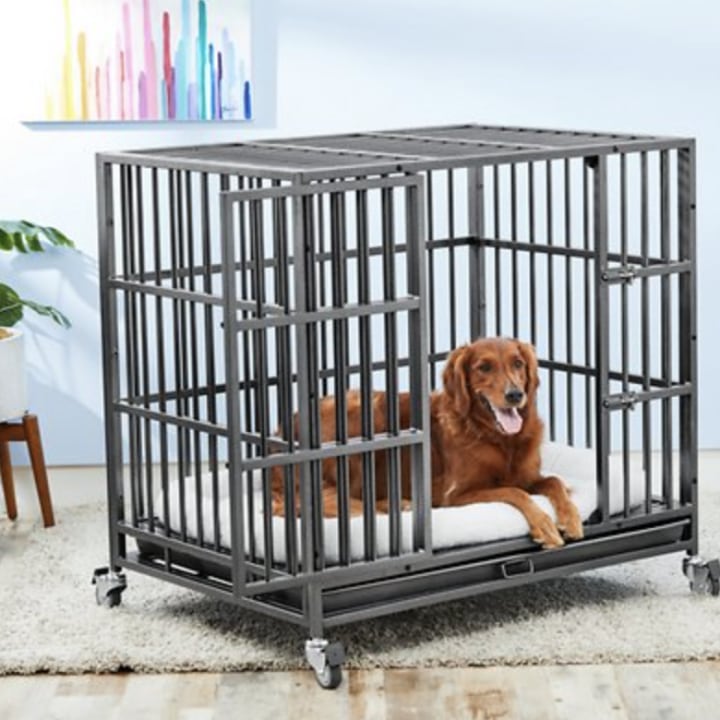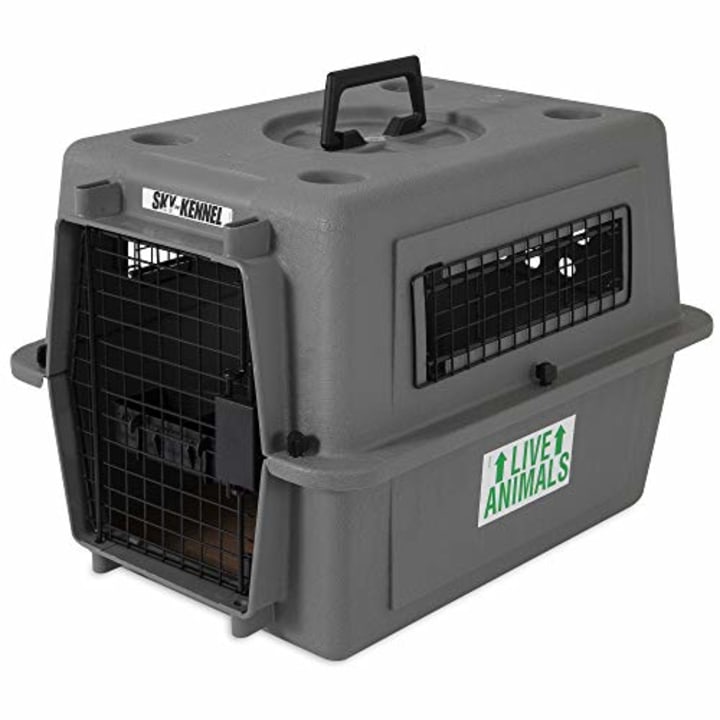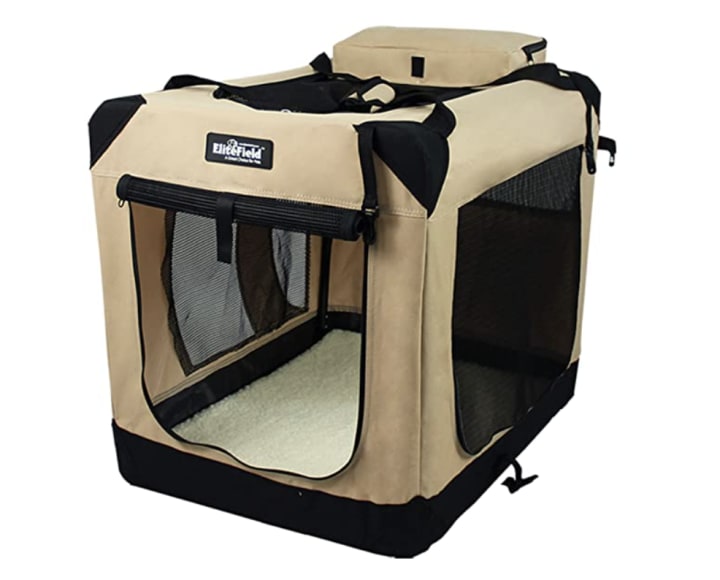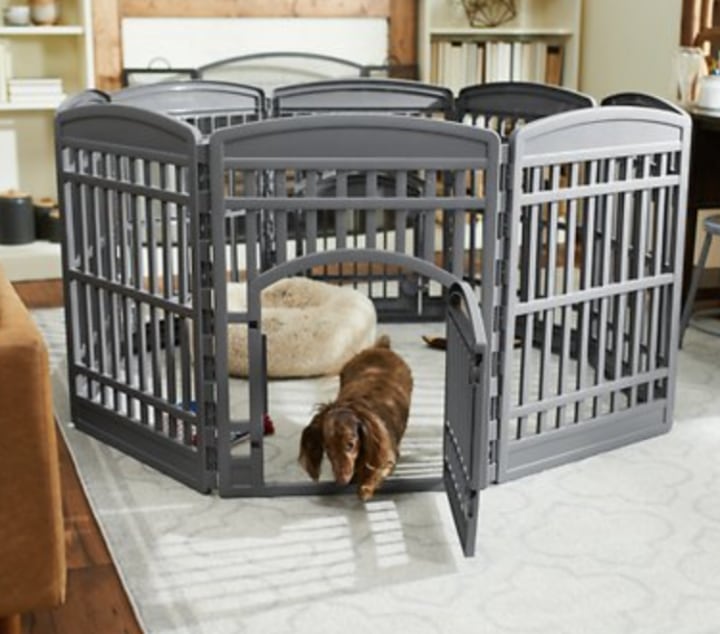Over the past year, being able to spend more time with our dogs has been a source of comfort and solace for many. But as some Americans prepare to head back to in-person work, the idea of leaving their dogs alone may be daunting. Many veterinarians recommend crate training as a good option to keep dogs from getting into messy (and dangerous) situations while home alone, all while having a comfortable spot when they’re stressed.
SKIP AHEAD Best dog crates in 2021
What are the benefits of crate training?
Confining your dog to a crate can cause feelings of guilt, but crate training can give both you and your dog peace of mind. While successful crate training involves a lot of time and patience — the process usually takes at least six months, according to the American Kennel Club — it can play an essential role in housebreaking puppies, while also creating a safe space for both young and older dogs, noted Zay Satchu, DVM, chief veterinary officer at Bond Vet in New York City.
A crate can be a dog’s way of relaxing when they feel anxious or distressed, especially in a big house. But, as Satchu pointed out, dog owners should always avoid using the crate as punishment or “as a result of a naughty behavior.” This will likely lead to the exact opposite effect — your dog will come to fear the crate and become even more stressed and anxious when they enter it.
When used responsibly, the crate can also limit a puppy’s access to the rest of the house and prevent them from chewing on housewares or getting into dangerous situations. Keep in mind, however, that dogs can’t be in crates for too long. While each dog has different physical activity requirements, dogs at any age have their limit before they need a bathroom break.
Types of dog crates
Dog crates come in different sizes, shapes and materials, and getting the right crate for your dog is a crucial first step.
Fabric or soft-sided dog crates: These types of crates are lightweight and portable, making them easy to carry while traveling. They also tend to fold down for easier storage. However, Stephanie Austin, DVM, the medical director at Bond Vet, suggests only using these for temporary crating as they’re hard to clean, not very durable and “easy to escape from — especially for dogs that like to chew on or paw at their crate.”
Metal dog crates: These crates are the most durable option for dog owners, especially if your dog likes to chew. Metal crates usually have bars with space between them, which means they are typically well-ventilated and keep your dog visible. They can also be folded for storage or travel. According to Austin, metal crates “can be modified in a variety of ways with dividers, crate covers and DIY furniture built around them to camouflage into surrounding home decor.”
Plastic dog crates: This portable, lightweight crate is generally used for plane travel and provides a little more privacy compared to metal dog crates. They’re also typically sturdier and easier to clean than soft-sided crates, though they don’t fold for easy storage.
Play pens or exercise pens: Play pens are a more spacious option for keeping your dog confined when you leave the house. Austin notes that these can also be combined with your dog’s crate to set up a “play zone,” though they’re not ideal for bigger dogs or ones that know how to jump and climb.
What to consider when buying the right sized crate
If you’re crate training a puppy, talk with your veterinarian to predict your pup’s adult size and purchase the coinciding crate. However, you don’t want to give your puppy too much space since it can undo their potty training “if they learn it's okay to potty in one corner and sleep in the other,” said Austin. She suggested purchasing a crate that includes a divider panel so you can increase the space as your puppy grows.
For finding the right size crate, here are some factors worth considering, according to the experts:
- Length: While your dog is standing on all fours, Austin recommends measuring them “from the tip of the nose to the base of the tail,” making sure not to include their full tail length. Then, “add 2 to 4 inches to this measurement for the best length of crate for your dog.”
- Height: “When your dog is in a sitting position, measure from the floor to the top of their head,” she said. “Add 2 to 4 inches to this measurement for the minimum height needed.”
- Width: According to Austin, there’s no need to measure your dog’s width — the crate’s width is based on their length and height measurements.
- Weight limit: Carefully check the weight limit of any crate you’re considering. Ensuring that your dog is within the manufacturer’s weight limit is important for safely carrying or traveling with the crate.
Best dog crates in 2021
Based on the expert guidance above, we’ve compiled the best dog crates to consider for you and your pet.
Best dog crate overall: Midwest
Midwest Large Double Door iCrate
The Midwest iCrate is easy to assemble (and disassemble), and has space between its metal bars for visibility and breathability for your pup. The sizes range from 18 inches to 48 inches in length, and the crate comes with either a single door or double door option. The crate door securely latches shut via a sliding bolt, reducing the likelihood of your dog escaping. A strong and determined dog may be able to unlatch it, though, so it’s important to get your dog used to the crate before leaving them unattended.
Best heavy-duty dog crate: Frisco
Frisco Ultimate Heavy Duty Metal Dog Crate
The Ultimate Dog Crate by Frisco is made of 22-gauge, high-grade steel with one-half-inch diameter bars that your dog will have a tough time chewing through. It also includes a dual latch lock, which the brand claims is positioned out of reach of curious pups. At just over 102 pounds, the crate is heavy, but it has built-in wheels and foot breaks for easy transportation. This Frisco crate also features a grated floor along with a removable metal tray to clean up any accidents.
Best airplane-friendly dog crate: Petmate
Petmate Sky Kennel Pet Carrier
This crate includes a four-point vault door for security and a hard plastic exterior that’ll give you some peace of mind (and your pup some privacy) during air travel. The carrier has open steel wire vents on three sides and more than a dozen holes in the back for proper ventilation. It also comes with clip-on food and water bowls for traveling. While this carrier meets most airline requirements for pet carriers, always double-check before you fly.
Best portable dog crate: EliteField
EliteField 3-Door Folding Soft Dog Crate
This soft-sided crate by EliteField is easily collapsible and turns into a portable tote for easy traveling. It comes with a removable, machine washable bed and breathable mesh on all four sides for comfort and ventilation.
Best play pen dog crate: Frisco
Frisco 8-Panel Plastic Exercise Dog Playpen
This play pen by Frisco can provide up to 18 square feet of play space for your pup. Each of the pen’s eight interlocking panels feature non-skid rubber feet that will keep it securely in place.
Tips for crate training your dog
How long the crate training process takes depends on several factors — including the dog’s past experience, age and temperament — but hurrying the process or making mistakes that can cause negative associations with the crate drag it out even longer. David Birse, DVM, the regional director at Bond Vet, noted that some mistakes, like leaving your dog in their crate for a long period of time without building up to it, “can really set you back” and have a psychological impact on your dog.
Here are a few tips for making sure the crate training process is smooth and successful:
Gently introduce it: Place the crate in a space where your dog is clearly comfortable and introduce it using a calm and happy tone. Birse recommends placing a few toys or treats inside of the crate so your pup has positive associations toward it. He also suggests adding a dog bed or blankets to maximize comfort and feeding your dog meals from inside their crate, which can encourage them to have positive associations towards it.
Be patient: The process for crate training a dog can be time-consuming, so make sure it’s something you can and are willing to commit to. “It's really important to have the patience to get them used to it, so that they're happy and they understand that they can investigate it a little bit,” said Birse.
Never force them in: “It’s just going to exacerbate their existing anxiety,” said Birse. “If your goal is for this to be a long-term situation for the dog, then that’s counterproductive.”
Keep it accessible: If your dog is older and initially anxious about the crate, Birse suggests keeping the door open throughout the day so they can go in and out voluntarily, and building up to the point where they’re comfortable with the door shut.
Always take off the collar: There’s a risk associated with a dog’s collar getting stuck on one of the crate’s wires, especially with open metal crates. Make sure to never place your dog inside a crate with their collar on.
Catch up on Select's in-depth coverage of personal finance, tech and tools, wellness and more, and follow us on Facebook, Instagram and Twitter to stay up to date.
